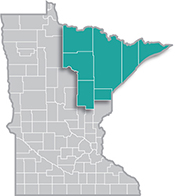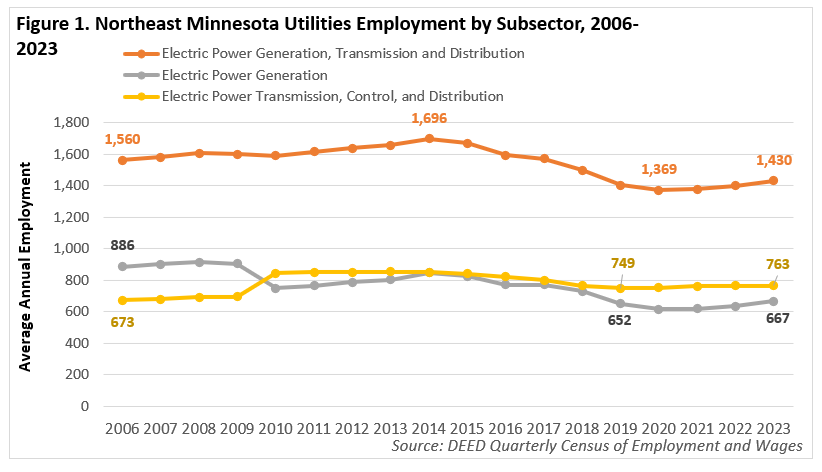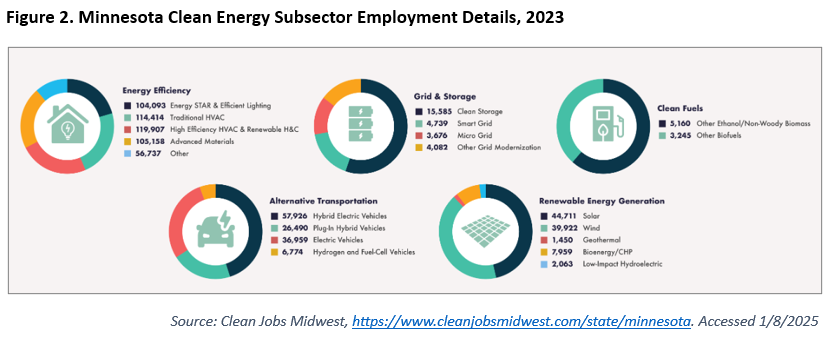 Home to the state's second-largest metro, the Northeast Region has a strong industrial sector, tied largely to the area's abundant natural resources.
Home to the state's second-largest metro, the Northeast Region has a strong industrial sector, tied largely to the area's abundant natural resources.
Most of the manufacturing base centers on mining and forest products industries. More than half of the sector's employment is in paper and machinery manufacturing.
Want the freshest data delivered by email? Subscribe to our regional newsletters.
1/31/2025 2:33:24 PM
Carson Gorecki
A bill recently passed by the Minnesota Legislature set a goal of zero greenhouse gas (GHG) emissions from electricity generation by 2040. In Northeast Minnesota, the push toward cleaner energy generation has taken many forms. The developments receiving perhaps the most attention have been the retirement of the region's coal-fired power plants. As of 2024, Minnesota Power has retired seven out of nine of its coal plants. The Taconite Harbor coal-fired plant in Schroeder ceased operations in 2016. Most recently, the Boswell Energy Center in Cohasset ceased operation of two of four units, and plans to retire the remaining two by 2030 and 2035, respectively1. Those retirements would mean the end of coal-fired electric power generation in the region.
As part of the transition away from coal and other fossil fuels, new sources of power generation will be required, but so will new means of transmission, distribution, storage, and consumption. These transitions are expected to have wide-ranging impacts, including on employment and the labor market of the region.
Employment impacts from the energy transition may already be discernible. Since peaking in 2014, employment in the Electric Power Generation, Transmission and Distribution sector declined to a low of 1,369 jobs in 2019, before rebounding slightly to 1,430 in 2023 (see Figure 1). Electric Power Generation employment accounted for the majority of the sector until 2010, when Electric Power Transmission, Control and Distribution took over. Some of that change may be attributable to how Utilities employment was classified. In 2011, the share of Electric Power Generation employment in the region tied to Fossil Fuel Electric Power Generation was just under 96%. By 2020, the share declined to a record low of 88%, only to climb back up to 90.7% by 2023.

Many terms are used to describe jobs supporting the transition away from a higher GHG-producing and carbon-intensive economy. Green, clean, sustainable, energy-efficient, and renewable are just a few of the more commonly used terms. A popular framework to characterize the energy transition's effects on employment is that of the U.S. Department of Energy's Energy and Employment Jobs Report (USEER). The USEER approach, which goes down to the county level, reports employment by energy sector and technology type: 1) Electric Power Generation; 2) Fuels; 3) Transmission, Distribution and Storage; 4) Energy Efficiency; and 5) Motor Vehicles2. Further honing this framework are Environmental Entrepreneurs and Clean Energy Economy Minnesota, resulting in the Clean Jobs America and Clean Jobs Midwest Reports. Through all these different approaches one thing is clear: there is not yet a universally agreed upon set of terms to describe how jobs are changing or how clean/green employment is defined.

The Pandemic Recession in 2020 appears to have put a dent in the movement toward clean energy employment growth, but the most recent year of data may indicate a renewed expansion. Within clean energy employment, the largest share by far was under the "Energy Efficiency" category, which accounted for 28% of all energy and 87% of clean energy employment. In terms of growth, clean energy power generation added over 100 jobs since 2020, but still only accounted for 1.9% of all energy employment. It is worth noting that the USEER framework does not consider traditional hydroelectric or woody biomass power generation to be clean energy. Those two sources are present in our region and account for a small, albeit growing, share of electric power generation jobs3.
As terminology and data are refined and greater consensus is reached, we will have an increasingly accurate picture of the local employment impacts from the energy transition.
If you would like more information on green and clean employment definitions and trends in Minnesota, check out this /deed/newscenter/publications/trends/june-2024/green.jspmore detailed statewide article by DEED LMI researcher Molly Ingram. I also recommend visiting /deed/programs-services/energy-transition/index.jspDEED's Energy Transition Office website. The Energy Transition Office is tasked with helping communities as they move away from fossil fuels.
For more information about energy employment in Northeast Minnesota, contact Carson Gorecki at carson.gorecki@state.mn.us or visit CareerForceMN's Find a Job.
1The final retirement of the Boswell Energy Center and community energy transition in Itasca County is a subject of focus for the Itasca Economic Development Corporation.
2Because the technologies and sectors of interest to the Department of Energy (DOE) do not perfectly align with publicly available employment data, the DOE uses survey data to estimate what share of employment corresponds to their technology and sector definitions.
3According to 2023 DEED Quarterly Census of Employment and Wages.